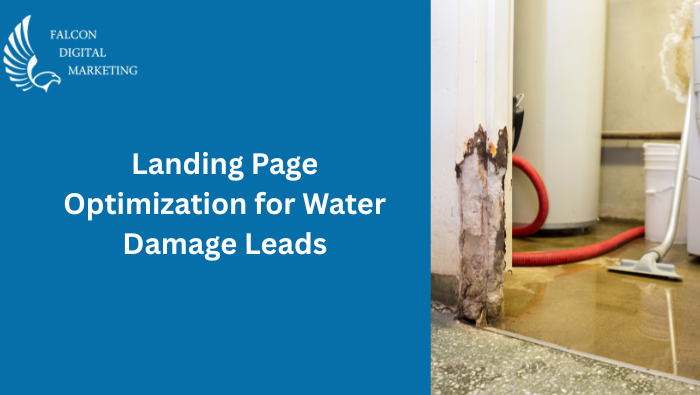Getting more water damage leads starts with your landing page. To convert urgency into action, your page must load fast, work on mobile, and make it easy for visitors to contact you. Homeowners and property managers searching after a flood don’t have time to browse, they need quick answers and clear steps.
If your Pay-Per-Click (PPC) ads are generating clicks but not conversions, your landing page could be the problem. At Falcon Digital Marketing, we help service-based businesses turn web traffic into booked jobs through strategic landing page optimization.
Let’s walk through how to optimize your landing page so you get more calls, more form fills, and better leads.
What Is Landing Page Optimization?
Landing Page Optimization (LPO) means adjusting your page layout, content, and calls to action to get more conversions.
In short, it’s about turning visitors into water damage leads.
A good landing page:
- Loads fast on desktop and mobile
- Speaks to the visitor’s pain point
- Has a clear path to action
If your ads lead people to a slow, cluttered, or generic page, they’ll bounce. That means wasted ad spend and fewer leads.
Why Landing Page Optimization Matters for Water Damage Leads
Water damage is urgent. People are looking for help right now.
That means your landing page must:
- Build trust in under 10 seconds
- Make it easy to call or fill out a form
- Remove anything that causes hesitation
When someone finds your page after searching “emergency flood cleanup near me,” they’re not there to browse. They want fast answers and clear next steps.
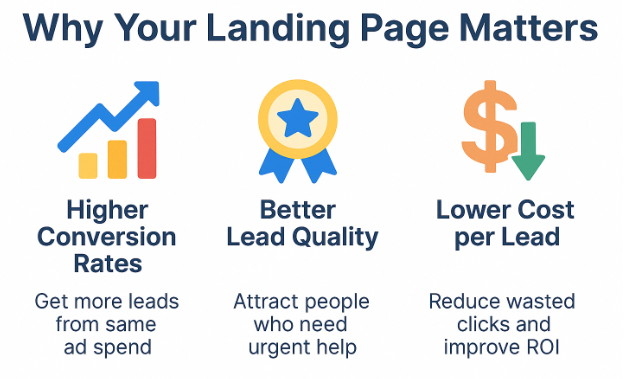
How to Optimize Landing Pages for Water Damage Leads
If you want more water damage leads, your landing page needs to do more than just look good. It needs to speak directly to people in crisis, homeowners, property managers, and insurance adjusters, who need help fast.
That means focusing on clarity, speed, and strategy.
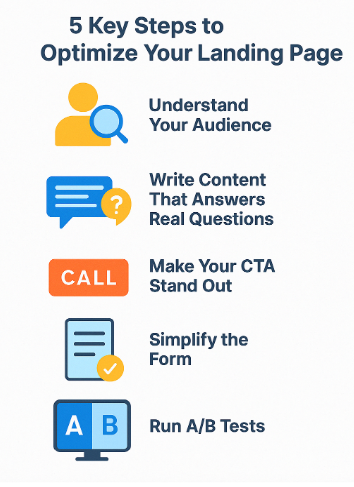
Let’s walk through how to optimize your landing pages for better performance and higher-quality leads.
1. Understand Your Audience
Before you build anything, you need to know who you’re talking to.
In water damage restoration, your typical audience includes:
- Homeowners with unexpected flooding
- Property managers dealing with tenant damage
- Realtors and adjusters coordinating emergency work
Each group has different priorities, but they all want the same thing: fast, reliable service.
We recommend starting with:
- Market research using surveys or customer interviews
- Reviewing competitor sites for messaging gaps
- Reading reviews to identify common pain points
What are people afraid of? Delays, costs, or shady contractors?
Use that insight to shape your headlines, visuals, and callouts.
2. Write Content That Answers Real Questions
People dealing with water damage aren’t casually browsing. They’re stressed. Your content should reflect that urgency and offer real solutions.
Use language that’s:
- Direct: “We respond within 60 minutes.”
- Helpful: “Here’s what to do while you wait.”
- Trust-building: “Licensed, insured, and bonded.”
Include real-world examples, not vague claims. If you helped a warehouse reopen in 24 hours after flooding, mention it.
Also:
- Add keywords like “emergency water extraction” or “24/7 flood cleanup”
- Use short paragraphs and clear headings
- Include before-and-after photos where possible

3. Make Your Call-to-Action Stand Out
Your call-to-action (CTA) is where everything comes together. It should be easy to find, easy to understand, and easy to act on.
Use language that reflects urgency and outcome:
- “Get a Free Quote in 60 Seconds”
- “Book Emergency Cleanup Now”
- “We’ll Be There in Under 1 Hour”
Add emotion where appropriate. “Don’t wait! Water damage gets worse fast” can prompt quicker action than a generic “Contact Us.”
Key CTA improvements:
- Use contrasting button colors
- Repeat the CTA in multiple places
- Keep the wording short but specific
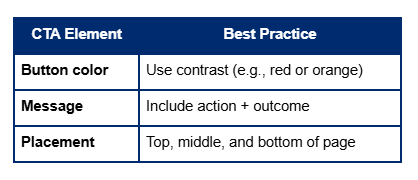
4. Simplify the Form
If your form has too many fields, people will bail. Keep it short.
Ask only what’s necessary to qualify the lead:
- Name
- Phone
- Address (optional)
- Brief description of damage
Avoid dropdown menus unless you need them. Use checkboxes instead when asking about service types or availability windows.
Tips for better form performance:
- Label each field clearly
- Display error messages immediately if something’s missing
- Make sure the form works on mobile
Also, test auto-filling fields where possible. This saves the visitor time and keeps your conversions moving.
5. Run A/B Tests and Iterate Weekly
Landing page performance isn’t static. It should improve over time with consistent testing.
Start with simple A/B tests:
- Headline A vs. headline B
- “Call Now” vs. “Get Help Fast”
- Long form vs. short form
Track metrics like:
- Click-through rate (CTR)
- Form submission rate
- Time on page
- Bounce rate
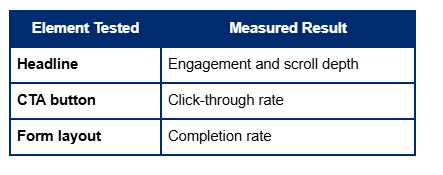
Make one change at a time. Let the data guide your next move. Don’t guess.
What Are the Best Practices for Landing Page Optimization?
Your landing page is more than a digital flyer. It’s your conversion tool. For restoration companies trying to drive more water damage leads, the difference between a click and a customer often comes down to what happens on that page.
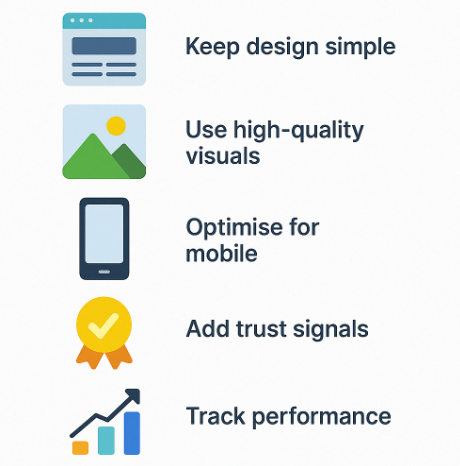
Here¿s how to turn landing pages into lead engines:
1. Keep the Design Simple and Focused
A clean layout helps visitors take action faster.
Most people landing on your site after a flood or pipe burst are under stress. They don’t want to scroll through clutter or guess where to click.
Key design tips:
- Use calming colors like blues or soft grays
- Stick to one or two fonts that are easy to read
- Leave space between elements so the content doesn’t overwhelm
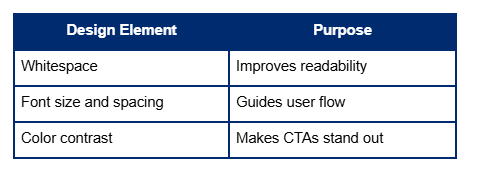
Simple design helps your message come through. When the layout is clear, users can focus on what matters: getting help.
2. Use High-Quality Visuals That Show Results
People trust what they can see. When it comes to water damage restoration, before-and-after photos do more than words.
Visuals tell your story fast.
Try:
- Side-by-side cleanup transformations
- Team-in-action shots during emergency calls
- Video testimonials from past clients
Don’t use generic stock images. If your crew is out in the field, snap real photos. Then post those with a quick caption explaining the job.
This approach makes your landing page feel authentic and builds trust faster.
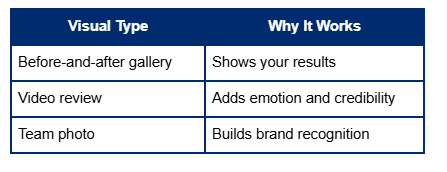
Good visuals should also be optimized for speed. Compress large files to avoid slow loading times, especially on mobile.
3. Make Sure the Page Works on Mobile
Most water damage leads start on mobile.
That means if your page loads slow or the text is hard to read on a phone, you’re losing business.
To fix that:
- Use responsive design so layouts adjust to screen size
- Test forms and buttons on multiple devices
- Cut down on extra scripts that slow down load time
Speed matters. According to Google, bounce rates jump 32% when a page load time increases from 1 second to 3 seconds.
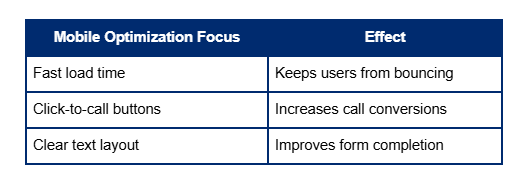
Run Google’s Mobile-Friendly Test regularly to check performance.
4. Add Trust Signals and Social Proof
If you say you’re reliable, that’s one thing.
When your customers say it, that’s what converts.
Add reviews, testimonials, and third-party ratings directly on your landing page. Focus on messages that speak to:
- Fast response
- Clean and professional crew
- Insurance billing support
Also include:
- Google star ratings
- Yelp badges or BBB accreditation
- Client logos (if applicable)
Place these near your CTA buttons or in a sticky sidebar for visibility.

If a visitor sees another homeowner praising your work, they’re more likely to fill out that form.
5. Evaluate Performance and Track What Works
You can’t optimize what you don’t measure.
At Falcon, we use A/B testing to tweak landing pages every week. Small changes in wording, layout, or CTA color can mean big gains in conversions.
Things to test:
- CTA phrasing: “Get Help Now” vs. “Request Free Estimate”
- Hero images: Flooded home vs. cleanup crew at work
- Headline variations
Track metrics like:
- Conversion rate (leads generated per visit)
- Bounce rate (how fast people leave the page)
- Click-through rate on call buttons
![]()
The goal isn’t perfection. It’s steady improvement.
Falcon Digital Marketing for Water Damage Leads
At Falcon Digital Marketing, we build landing pages that don’t just look good, they generate real, qualified leads for restoration businesses.
You get a system built to scale with your growth. Whether you’re starting in one service area or expanding across multiple markets, our team tracks every click, call, and form fill.
Want to see how your current page compares?
Let’s take a look together.
FAQ
How can landing page optimization benefit my water damage business?
A well-optimized landing page brings in more qualified leads and makes it easier for people to take action.
Here’s what you get:
- More calls and form submissions from people ready to book
- A stronger presence in local search results
- Better results from your Google Ads and social media traffic
What are the key elements of a successful landing page for water damage leads?
A successful landing page is clear, fast, and focused.
It includes:
- A headline that matches the user’s search intent
- Simple, benefit-driven content
- High-quality visuals (like before-and-after photos)
- Trust elements such as certifications and reviews
- A bold call-to-action with a visible phone number or form
- Mobile-first layout with fast loading times
Each part should guide the user toward one goal: contacting your team.
If you try to include too many links, distractions, or technical jargon, it creates friction. Keep it simple and direct.
How does Falcon Digital Marketing optimize landing pages for water damage leads?
At Falcon, we take a hands-on, data-first approach.
We start by reviewing your existing landing page performance. Then we build or redesign a version built for speed, clarity, and conversion.
Our optimization process includes:
- Keyword alignment with your paid and organic traffic
- A/B testing for headlines, images, and CTAs
- Mobile performance audits and improvements
- Call tracking setup to tie leads to ad spend
- Integrating social proof and client reviews
We also run heatmaps and user session recordings so we can see where visitors click and where they drop off.
This isn’t guesswork. It’s built on testing, tracking, and continuous improvement.
Can I optimize my landing page for water damage leads on my own?
Yes, but there are trade-offs.
You can build and test your own page using tools like Google Optimize, WordPress, or page builders like Unbounce or Instapage. But it takes time to learn conversion principles, split testing methods, and platform integrations.
If you’re already handling operations, team scheduling, or emergency response, it might be hard to give your landing page the focus it needs. With us, you stay focused on delivering great service, while we handle your digital performance.
Other Articles You Might Also Be Interested In:
- How to Get More Water Damage Leads
- Customer Testimonial Collection Techniques for Water Damage Leads

